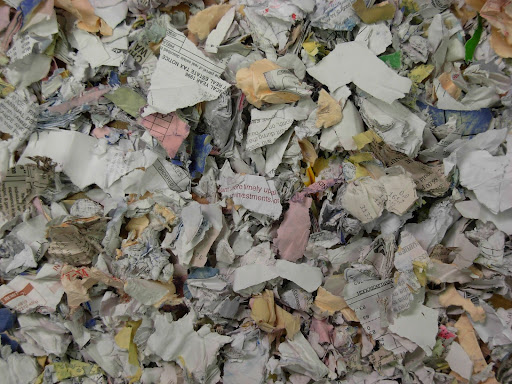You don’t have to have decades of experience in the paper shredding industry to understand the core differences among cross-cut, strip-cut and pierce and tear commercial paper shredders. One cuts paper both vertically and horizontally to create confetti-like shreds, another pokes holes and rips up the material, while the other only cuts paper into vertical strips. All three can potentially fulfill a small business’s shredding needs. And all also have drawbacks. There are several key factors to consider when you’re evaluating your commercial paper shredder options.
Comparing Cross-Cut, Strip-Cut and Pierce and Tear Commercial Paper Shredders

The commercial paper shredders that are marketed to small businesses generally share a number of characteristics. They’re usually about the size of a large recycling bin and have to be placed near a power source. They’re simple (though noisy) to operate and can shred multiple sheets of paper at once. And they’re prone to jams.
Cross-cut, strip-cut and pierce and tear commercial paper shredders are alike in these ways, but they also have some significant differences. These are the factors business leaders need to think about when comparing shredding equipment.
- Data security. Any time you’re evaluating document shredding services for your business, protecting data security needs to be the top concern. After all, the whole point of shredding sensitive documents is to make them unreadable to anyone outside of your business. This is where cross-cut and pierce and tear shredders have the clear advantage. Different commercial paper shredders have different specs, but a strip shredder will generally cut paper into strips anywhere from 3/32” to 1/4” or even 1/2” wide. If a really motivated thief found a bag of your business’s shreds cut into 1/4”-wide strips, it would probably be possible for them to restore those documents. Cross-cut shredders cut documents into so many pieces that they can’t feasibly be reassembled. Depending on the model, a cross-cut shredder may turn a single sheet of paper into several hundred pieces. Pierce and tear is the most secure as they rip materials apart, using rotating blades to pierce holes and tear them into tiny and indistinguishable shreds that are virtually impossible to reconstruct. These shredders are designed for high-capacity shredding facilities and can destroy thousands of pounds or even tons of materials every hour. This is the kind of shredder that Northeast Data Destruction uses to securely destroy our clients’ sensitive data.
- Price. Buying a commercial paper shredder for your business typically requires an investment of at least $1,000 and sometimes much more. Cross-cut shredders generally cost more than strip-cut shredders, but a shredder’s capacity and its features also affect its price. Keep in mind that bringing a commercial paper shredder onsite also means slightly higher electricity costs plus maintenance costs. You’ll also be paying for employee time that’s spent using and maintaining the shredder. Because pierce and tear shredders are designed for high-capacity and are primarily used by document shredding facilities, they are typically price prohibitive for small businesses. Commercial sites will also pair a pierce and tear type shredder with infeed and discharge conveyors, as well as a horizontal baler and a dust collection system for high production processing.
- Ability to shred non-paper items. Protecting your business’s sensitive data requires you to shred more than just paper. Payment cards, ID cards, access badges, hard drives and other data-storing devices must also be shredded when they reach end of life. Both strip-cut and cross-cut commercial paper shredders generally have the ability to shred credit cards. Some heavy-duty models may be able to handle staples and paper clips and even shred discs like CDs. But don’t expect any of the shredders available in stores to be powerful enough to shred hard drives. For that, you’ll always need to work with a secure shredding service.
- Maintenance. Any type of commercial paper shredder requires frequent maintenance. A shredder’s blades get dull and coated by paper fibers over time. The blades need to be oiled often to keep them sharp so the shredder runs efficiently. Cross-cut and pierce and tear shredders make a lot more cuts than strip shredders, so they need to be oiled much more often. Plan to lubricate the blades with shredder oil or lubricant sheets (depending on manufacturer care instructions) every time the shredder’s bag needs to be emptied.
- Mess. While it’s probably not a dealbreaker, emptying out a strip-cut shredder tends to be a slightly smaller hassle. But with any of the options, little shredded paper bits might end up littering the area where your shredder is kept, and they’re tough to clean up from carpeted floors.
Depending on your business’s document shredding needs, maintaining your own commercial paper shredder might not be worth the money and effort required. Working with a professional document shredding service allows your employees to focus on the work you pay them to do. It can also afford you the peace of mind that comes with knowing every sensitive document, payment card or hard drive your business gets rid of is going to be permanently destroyed. Northeast Data Destruction provides secure pickup services for all your sensitive materials, including paper documents and data-storing devices like hard drives. Our high-volume pierce and tear shredder can destroy shreddable material in a fraction of the time it takes to use a commercial paper shredder. Someone from your organization can even witness the shredding at our NAID “AAA” certified shredding facility if you wish. If you have any questions about your business’s shredding needs, contact me today.
